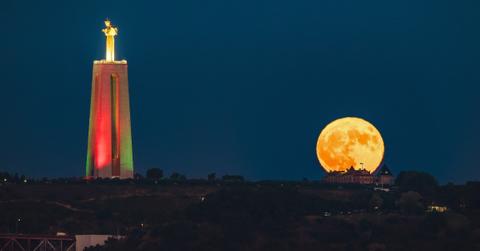Experts Have a Logical Explanation for Why the Moon Sometimes Looks More Orange Than Usual
The moon's color fluctuates from time to time.
Published Oct. 15 2024, 1:08 p.m. ET

There was a time when people were convinced, for whatever reason, that the moon and cheese had something to do with each other. And, while we now know that to be so painfully untrue, there are often other questions about that rock in outer space, including why the moon looks orange. Sometimes, it appears as more of a yellow or even white color too.
When it comes down to it, there is a perfectly logical and perfectly scientific reason for the changing color of the moon. And we are sorry if you had hoped there was something more extraterrestrial and exciting behind the moon's seemingly color-changing abilities in space. But the why of it all makes sense when you think about it.

Why does the moon look orange?
According to the BBC Sky at Night Magazine, the moon looks orange sometimes because of the way light passes through it. This is particularly true when the moon is lower in the sky. At that time, the light of the moon has to go through a thicker part of the Earth and as a result, red or orange, which have longer wavelengths, appear in the moon's coloring.
When the moon is higher, the blue and green color wavelengths are more prevalent in the face of the moon. So typically, at night, or late into the nighttime hours, the moon takes on a different color than what you see in the early evening. Of course, there are times when there is a blood moon or a supermoon, and in those instances, it's a bit different.
What is a supermoon?
A supermoon might look orange in color and larger than usual all throughout the night rather than just as dusk approaches. That's because the moon is both full and close to the Earth. As a result, it takes on a much larger appearance. And sometimes, it's also a darker color than you might typically see as it sits in the sky on other nights.
While supermoons tend to make the round son social media often, the truth is that they aren't that common. In fact, supoermoons only happen a handful of times throughout the year. When it comes to moons that look orange, those are a bit more common. But supermoons aren't an everyday occurrence, which is what makes them so special to some people.
Why is a blood moon red?
When there's a blood moon, it means there is a total lunar eclipse. In this case, Earth is between the moon and the sun, which causes light to pass through the edges of the Earth's atmosphere and make the moon glow a reddish color.
The name is based on its red color, and although it's different from when the moon is orange, it's another phenomenon that even those who aren't wild about science tend to question.